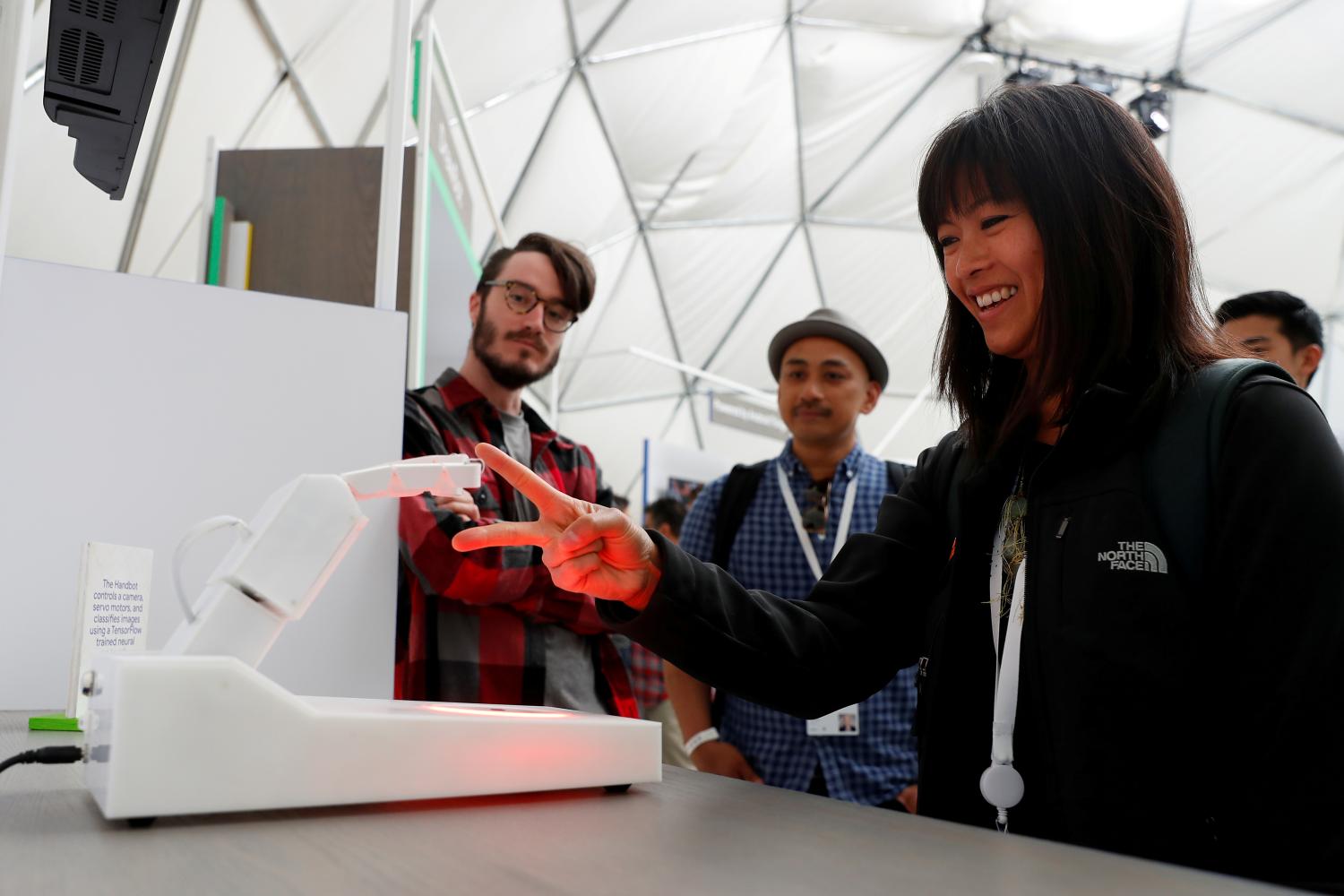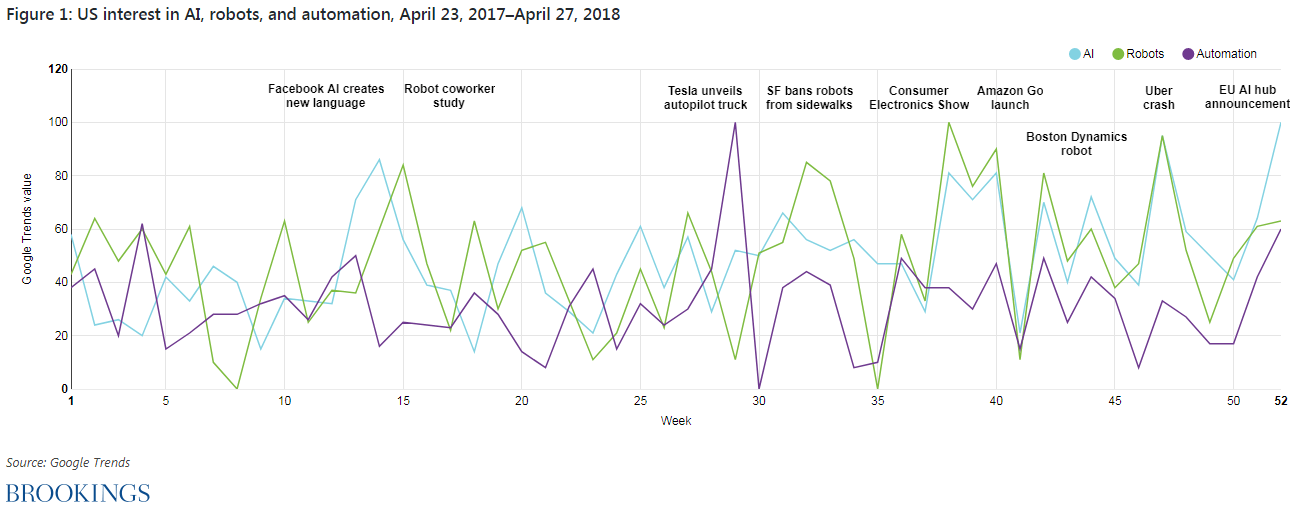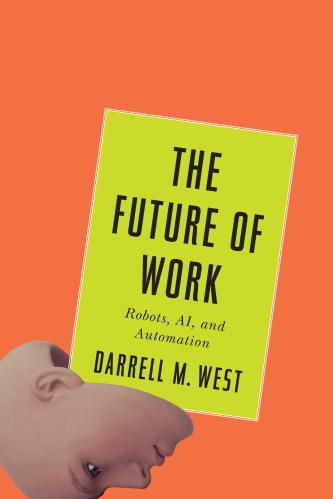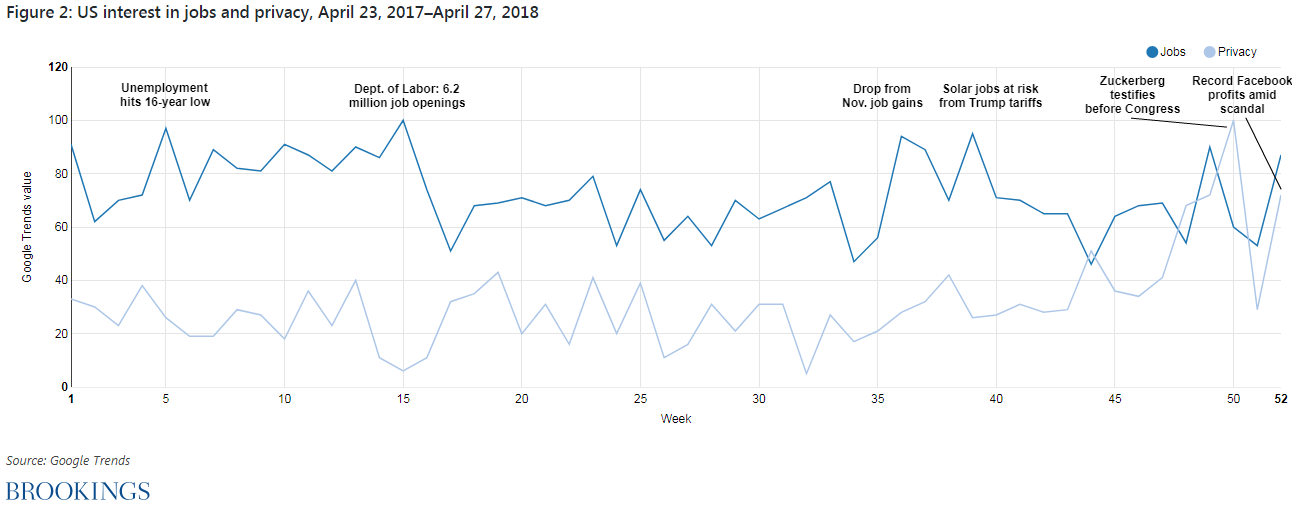Executive Summary
Artificial intelligence, robots, and automation are rising in importance in many areas. As noted in the recent book, “The Future of Work: Robots, AI, and Automation,” there are exciting advances in finance, transportation, national defense, smart cities, and health care, among other areas. Businesses are developing solutions that improve the efficiency and effectiveness of their operations and using these tools to improve the way their firms function.
Yet there also are concerns about the impact of these developments on jobs and personal privacy. A Pew Research Center national survey revealed considerable unease about emerging trends. It found that 65 percent of American adults think that in 50 years, robots and computers “will do much of the work currently done by humans.”1 A 2018 Brookings survey found that 49 percent on adult online users worry AI will reduce personal privacy and 38 percent fear it will cut the number of jobs.
Search interest in both AI and robotics correlated with major research breakthroughs.
In this paper, we look at views of AI, robots, and automation using internet search data. This report is the third in a series of big data analysis that charts long terms trends in online search trends. Our first report focused on views about Donald Trump in his first year as president, while our second one examined views about American democracy.2
The current analysis reveals several important results in views about technology developments:
- Search interest in both AI and robotics correlated with major research breakthroughs. A pair of Facebook AIs developed their own language to communicate, and another study found that humans are more comfortable with error-prone robots. News of these developments was associated with search interest in AI.
- Artificial intelligence and robotics are also being tested outside the laboratory. The Amazon Go convenience store uses AI to track customer purchases, while a growing number of companies are testing self-driving vehicles on public roads. Reports of fatal accidents in recent months highlighted the potential hazards of testing new technology.
- News that Cambridge Analytica accessed Facebook user data without authorization raised search interest in online privacy. The EU’s General Data Protection Regulation, which came into effect this month, also is associated with greater search activities around AI.
Internet search queries
Digital media platforms represent a lens through which to study contemporary developments. Tools like Google and Bing search, Facebook posts, Twitter tweets, and Instagram sharing reveal important clues about what is happening today. For example, the topics on which people search show what is of interest to them and how that interest changes over time.
The analysis of Google search trends has increased in recent years. Seth Stephens-Davidowitz used Google search trends to investigate how much racial animus cost Barack Obama in terms of votes during the 2008 and 2012 elections.3 Google search trends were especially useful in that study as traditional survey results asking white individuals whether they would vote for a black president may have masked an actual reluctance to do so.
Google search data also have been used to examine the agenda setting effects of television and newspaper coverage. Brian Weeks and Brian Southwell studied news coverage of the rumor that Obama was secretly a Muslim.4 By examining search trends prior to 2007, they demonstrated that the volume of news coverage of this rumor positively predicted aggregate Google searches of that idea.
Event histories and methodology
Event histories help to make sense of longitudinal data. Matching events that correspond to spikes in interest enable researchers to add context to the aggregate information. For example, company announcements or government actions often drive media and public interest in particular topics. The media report high-profile activities and the public responds by requesting information related to those events. Seeing the ups and downs in search behavior and matching those data points to actual events provides clues regarding the factors driving public interest.
From the standpoint of technology, the past year has been quite eventful.
From the standpoint of technology, the past year has been quite eventful. Research and development in AI and robotics produced Facebooks bots that created their own language to communicate and a Boston Dynamics robot that could open a door on its own. Amazon opened its Amazon Go convenience store to the public in January. Instead of cashiers, the store employs an array of cameras and artificial intelligence to track customer purchases and charge their Amazon accounts. March saw two fatal crashes involving semi-autonomous vehicles: An Uber car struck a pedestrian in Arizona and the driver of a Tesla hit a highway median in California. In April, Facebook CEO Mark Zuckerberg appeared before both chambers of Congress to answer questions related to the sharing of user data with Cambridge Analytica.
In this analysis, we use Google search queries and event histories to examine trends in views about technology over the past year. The data come from Google searches of the U.S. web between April 23, 2017 and April 27, 2018, and we use weekly search data to smooth the data into regular time intervals.
The topics analyzed include interest in artificial intelligence, robots, automation, jobs, and privacy. According to Google Trends, interest is defined as “search interest relative to the highest point on the chart for the given region and time. A value of 100 is the peak popularity for the term. A value of 50 means that the term is half as popular. Likewise a score of 0 means the term was less than 1% popular as the peak.”5
We focus on Google search because it includes 88 percent of the searches that take place in the United States, compared to 7 percent for Bing and 4 percent for Yahoo.6 It is important to note that since data are aggregated, it is not possible to break them down by age, gender, race, or other categories of possible interest. According to Google, its search data are normalized in order to facilitate comparability based on subject, time period, and location.
For a given search term, Google Trends data note that its information represents “an unbiased sample of Google search data. Only a percentage of searches are used to compile Trends data.” Our data was collected on April 28, 2018, which means that trend data analyzed at other points in time could yield different results.
Interest in artificial intelligence, robots, and automation
One of the highest peaks in interest in AI occurred in April when the European Union announced plans to launch its own AI research hub to compete with China and the United States. The U.S. is home to many technology companies working on various applications for AI, supplemented by academic researchers at leading universities. China has also announced a massive increase in funding for its own AI efforts. The EU announcing its own initiative shows the strategic importance of artificial intelligence.
One of the highest peaks in interest in AI occurred in April when the European Union announced plans to launch its own AI research hub to compete with China and the United States.
Peak interest in robots occurred in January 2018 during the Consumer Electronics Show in Las Vegas, where many technology companies debut new products for market or new technology in development. Robots displayed there include Sophia, a humanoid robot that can walk and talk. With greater use of sensors and artificial intelligence to gather and process information, robots are capable of a greater number of tasks. Boston Dynamics posted a video of a robot that could grasp a doorknob and open a door for another robot to pass through.
Search interest also peaked in March, around the time an autonomous Uber test vehicle struck and killed a pedestrian in Tempe, Ariz. Less than a week later, a crash also killed the driver of a Tesla in autonomous mode in Mountain View, Calif. These setbacks in driverless car testing raise the stakes for the technology: Any failures could cost lives, but success could save many more.
The highest interest in automation took place in October 2017, when Tesla announced that it would produce an all-electric semi-truck with its autonomous driving capability. Self-driving trucks could have major impacts on the work of 1.8 million truck drivers in the U.S. Some may transition to remotely managing fleets of autonomous trucks, or they may continue riding in trucks to navigate them through crowded cities. Driving for long stretches of time also makes trucking a relatively dangerous occupation, so autonomous vehicles could reduce fatigue and other hazards of the job.
Interest in artificial intelligence by metro area
The metropolitan area with the greatest interest in AI was Monroe, La. That was followed by Erie, Pa., Topeka, Kan., Charlottesville, Va., and San Francisco, Calif.
| Monroe, La. 100 | West Palm Beach, Fla. 31 |
| Erie, Pa. 75 | Champaign, Ill. 29 |
| Topeka, Kan. 63 | Flint-Saginaw, Mich. 29 |
| Charlottesville, Va. 62 | Toledo, Ohio 28 |
| San Francisco, Calif. 46 | Detroit, Mich. 28 |
| Tucson, Ariz. 42 | Seattle, Wash. 28 |
| Charleston, S.C. 38 | New Orleans, La. 28 |
| South Bend, Ind. 35 | Waco, Texas 28 |
| Tallahassee, Fla. 34 | Cincinnati, Ohio 27 |
| Boise, Idaho 32 | Burlington, Vt. 26 |
Interest in robots by metro area
The metropolitan area with the greatest interest in robots was Lubbock, Texas, followed by Lafayette, Ind., Rapid City, S.D., Billings, Mont., and Terre Haute, Ind.
| Lubbock, Texas 100 | Medford, Ore. 47 |
| Lafayette Ind. 91 | Tyler, Texas 39 |
| Rapid City, S.D. 87 | Albuquerque, N.M. 39 |
| Billings, Mont. 87 | Columbus, Ga. 38 |
| Terre Haute, Ind. 79 | Sioux Falls, S.D. 31 |
| Chico, Calif. 77 | Davenport, Iowa 30 |
| Ft. Wayne, Ind. 66 | Yakima, Wash. 29 |
| Huntsville, Ala. 64 | Fresno, Calif. 28 |
| Binghamton, N.Y. 58 | Mobile, Ala. 28 |
| Amarillo, Texas 51 | Ft. Smith, Ark. 24 |
Interest in automation by metro area
The metropolitan area with the greatest interest in automation was Sherman, Texas. That was followed by Lincoln, Neb., Panama City, Fla., Odessa, Texas, and Corpus Christi, Texas.
| Sherman, Texas 100 | Macon, Ga. 25 |
| Lincoln, Neb. 89 | Springfield, Mass. 22 |
| Panama City, Fla. 58 | Cedar Rapids, Iowa 21 |
| Odessa, Texas 54 | Buffalo, N.Y. 21 |
| Corpus Christi, Texas 42 | Monterey, Calif. 20 |
| Chico, Calif. 40 | Albuquerque, N.M. 20 |
| Yakima, Wash. 40 | Green Bay, Wis. 19 |
| Peoria, Ill. 31 | Lexington, Ky. 18 |
| Grand Rapids, Mich. 28 | San Francisco, Calif. 18 |
| Lansing, Mich. 26 | Boston, Mass. 17 |
Views about jobs and privacy
To see how people responded to technology developments, we also compiled data on searches for jobs and personal privacy. Jobs news in 2017 was mostly positive—the Department of Labor reported its lowest unemployment figures since before the Great Recession, and by August there were 6.2 million job openings reported. In January, President Trump announced a slate of tariffs against China that the U.S. solar industry claimed would imperil solar panel installation jobs.
Search volume for privacy remained steady throughout the year until the Cambridge Analytica scandal broke in late March of this year. The data analysis firm created a Facebook app that gathered data not just on its users, but also on friends in their network without their consent. Over two days of congressional hearings, Facebook CEO Mark Zuckerberg answered questions about how his company handles user data and what changes will prevent unauthorized sharing of data in the future. Weeks later, Facebook posted record profits and Cambridge Analytica field for bankruptcy.
Conclusions
To summarize, there were a number of major spikes in public interest in AI, robots, and automation over the past year. News stories about research breakthroughs in laboratories as well as real-world applications of artificial intelligence and robotics drove search interest in these technologies. Peaks in searches for news about jobs and privacy coincided respectively with reports about jobs numbers and Cambridge Analytica collecting data on Facebook users without their consent. Comparing the two groups of search terms, interest in jobs broadly correlates with interest in AI, robots, and automation, while privacy broadly correlates with AI. For better or worse, these technologies could have a major impact on the number and types of jobs that exist in the future. Artificial intelligence can make decisions based on collected personal information with important consequences for privacy. We expect AI, robots, and automation to continue to drive interest in jobs and privacy into the future.
News stories about research breakthroughs in laboratories as well as real-world applications of artificial intelligence and robotics drove search interest in these technologies.
It is important, of course, to keep in mind the limits of internet search data. First, they are highly aggregated, and it is not possible to break down the overall numbers by age, gender, race, or other important demographic categories. Second, they measure interest in a topic, but not the direction of sentiment. Third, search data are sensitive to the terms being queried.
Those points notwithstanding, though, internet search data rest on trillions of data points, provide information in real time, and measure trends over time. That helps analysts explore important topics such as views of democracy during the first year of Trump’s presidency and discern shifts in interest based on subject and time. As such, they represent a valuable technique for the exploration of contemporary developments.
-
Footnotes
- Aaron Smith, “Public Predictions for the Future of Workforce Automation,” Pew Research Center, March 10, 2016.
- Darrell M. West, “What Internet Search Data Reveals about Donald Trump’s First Year in Office.” Brookings (blog). January 17, 2018. https://www.brookings.edu/research/what-internet-search-data-reveal-about-donald-trumps-first-year-in-office/ and Darrell M. West and Jack Karsten, “Views about American Democracy,” Brookings (blog). April 4, 2018. https://www.brookings.edu/research/views-of-american-democracy-based-on-internet-search-data/
- Seth Stephens-Davidowitz, 2014. “The Cost of Racial Animus on a Black Candidate: Evidence Using Google Search Data.” Journal of Public Economics 118 (October): 26–40. https://doi.org/10.1016/j.jpubeco.2014.04.010.
- Brian Weeks and Brian Southwell, 2010. “The Symbiosis of News Coverage and Aggregate Online Search Behavior: Obama, Rumors, and Presidential Politics.” Mass Communication and Society 13 (4): 341–60. https://doi.org/10.1080/15205430903470532.
- The definition of “interest over time” is shown at https://trends.google.com.
- Stats Counter, “Search Engine Market Share in the United States,” 2017. http://gs.statcounter.com/search-engine-market-share/all/united-states-of-america.
The Brookings Institution is committed to quality, independence, and impact.
We are supported by a diverse array of funders. In line with our values and policies, each Brookings publication represents the sole views of its author(s).








